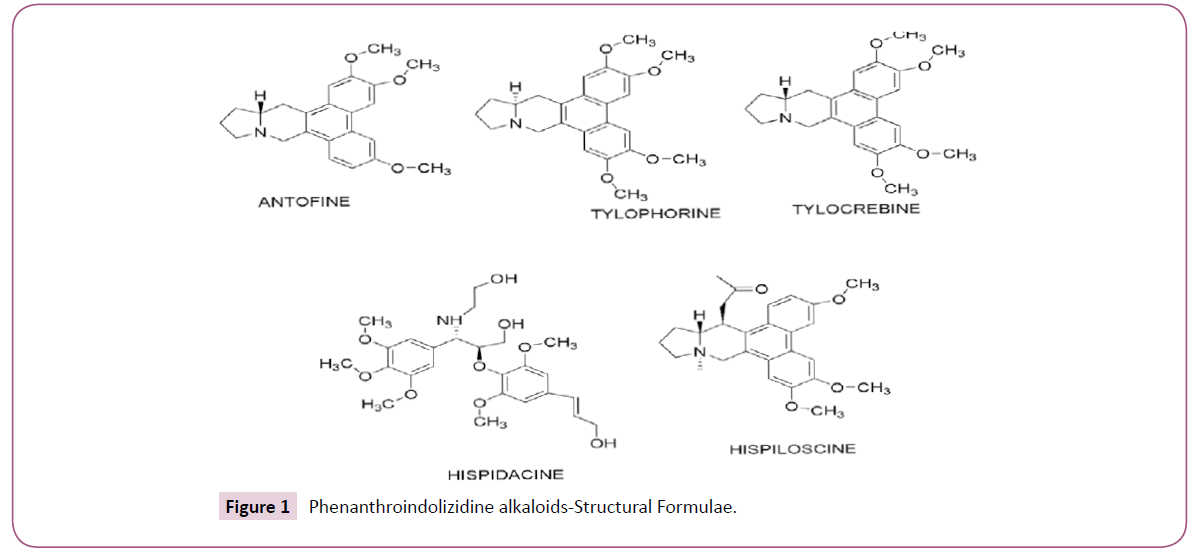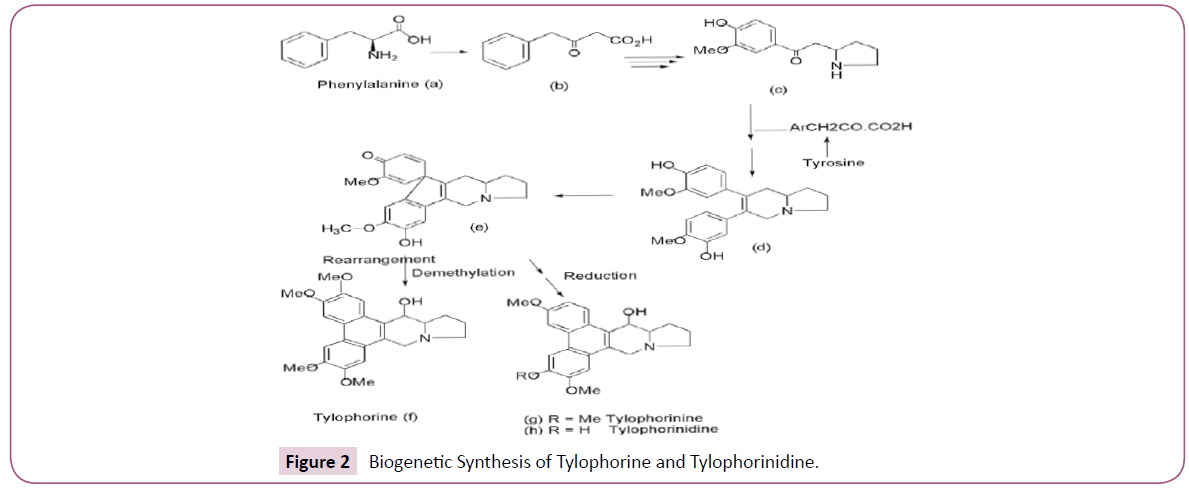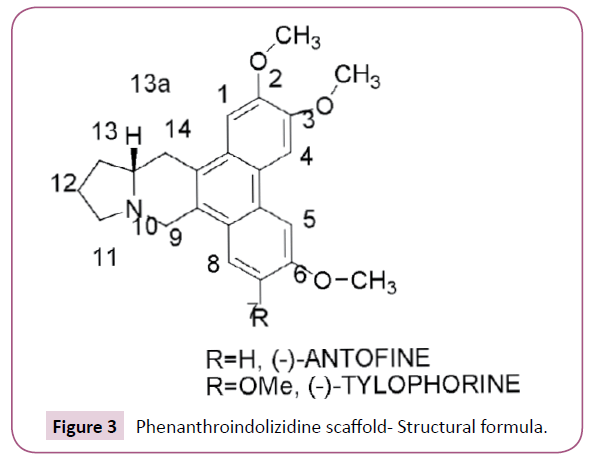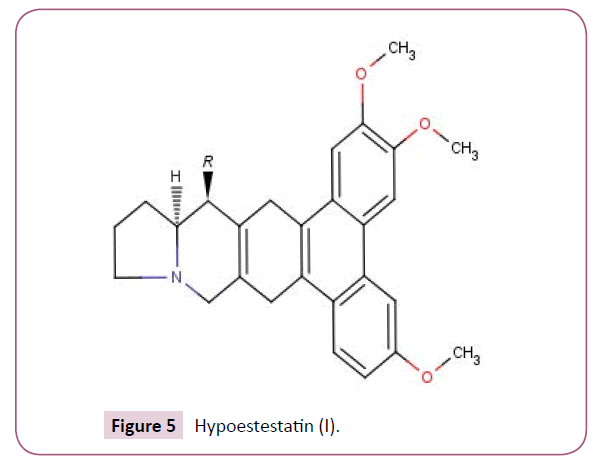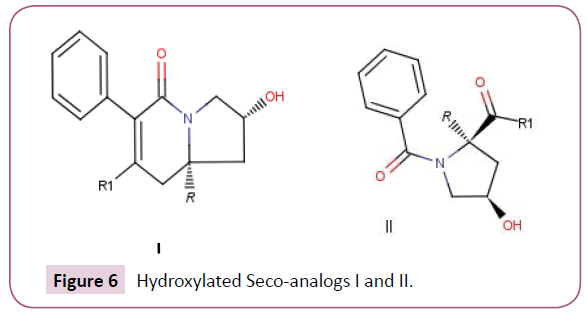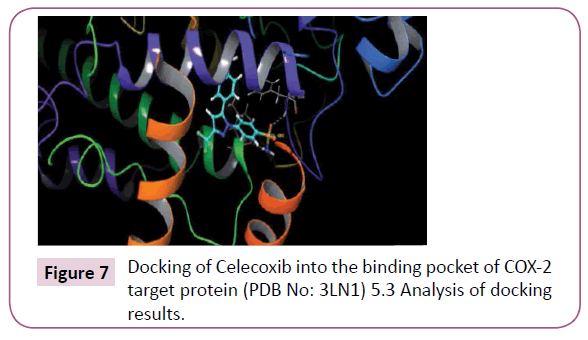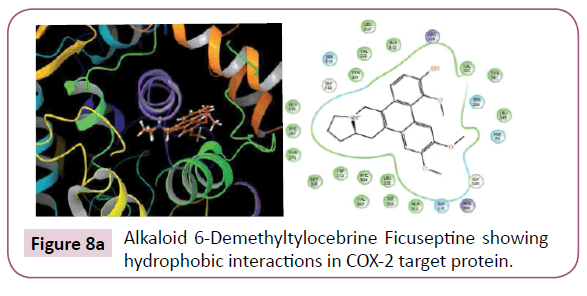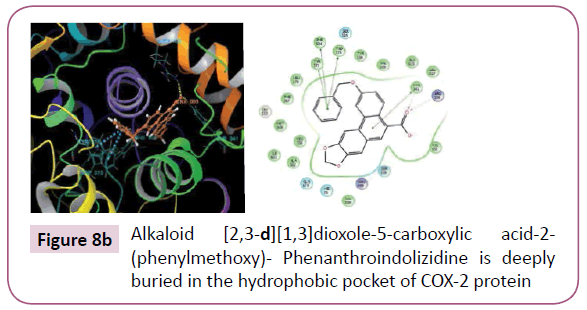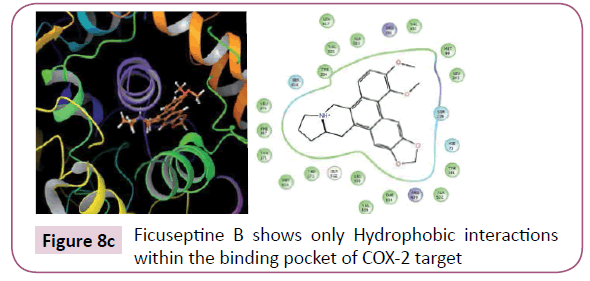Review on the Anticancer and In-silico Binding Studies of Phenanthroindolizidine Alkaloids
Anita A Mandhare, Sivakami A Dhulap, Abhijeet S Dhulap, Satish C Biradar
Anita A Mandhare*, Sivakami A Dhulap, Abhijeet S Dhulap, Satish C Biradar
CSIR Unit for Research and Development of Information Products “Tapovan”, NCL Campus, Pashan, Pune, India
- *Corresponding Author:
- Anita A Mandhare
CSIR Unit for Research and Development of Information Products “Tapovan”
NCL Campus, S. No. 113, 114, Pashan
Pune 411 008
India
Email: anita@urdip.res.in
Received date: 23 September 2014 Accepted date: 11 February 2015 Published date: 21 March 2015
Citation: Mandhare AA, Dhulap SA, Dhulap AS. Review on the Anticancer and In-silico Binding Studies of Phenanthroindolizidine Alkaloids. Chem Inform. 2015, 1:1.
Abstract
Background: Cancer is the major cause of death throughout the world. In the developing world, the rate of death increases due to old age and changes in the lifestyle of people. At present, the researchers from multidisciplinary areas are focusing on strategies to combat this disease. Several chemotherapeutic, cytotoxic and immunomodulatory drugs are being explored from natural sources like plants, insects and marine organisms. Alkaloids belonging to the phenanthroindolizidine class are an example of such phytochemicals isolated from natural sources and found to exhibit interesting pharmacological properties. These alkaloids are well known for their cytotoxic activity, due to the inhibition of protein and nucleic acid synthesis. Hence numerous approaches to synthesize the phenanthroindolizidines and their analogues have been reported.
Method and findings: This review will hence provide an overview on the anti-cancer effects of Phenanthroindolizidine Alkaloids (PAs) reported from scientific and patent literature. The details of the mode of actions, study models, effective dosages, combination therapy and other pharmacological aspects of the alkaloid will be highlighted. Some of these alkaloids were found to possess anti-cancer activity by inhibiting the overexpression of COX-2 enzyme and NF-kB receptors, the deregulation of which is found to cause tumors. Further studies related to the in-silico docking studies confirm their interaction with COX-2 protein which is one of the important targets for treating inflammation based cancer.
Keywords
Phenanthroindolizidine alkaloids; Anticancer; COX-2 enzyme; In-Silico studies; Cytotoxic; Patents
Abbreviations
PA: Phenanthroindolizidine Alkaloids; ATF: Activating Transcription Factor; CAMP: Cyclic Adenosine Monophosphate; CDK4: Cyclin-dependent Kinase-4; CNS: Central Nervous System; COX-2: Cyclooxygenase-2; DCB: The short three letter code of the molecule as entered in Protein data Bank which unique, y identified each component on PDBeChem; DHFR: Dihydrofolate Reductase; EC50: Half maximal Effective Concentration; IC50: Half maximal inhibitory Concentration; MDR: Multidrug Resistant; NF-KB: Nuclear factor-kappaB; NO: Nitric Oxide; PGL: Pergularinine; TNF: Tumor necrosis factor; TPD: Tylophorinidine; WHO: World Health Organization
Introduction
Cancer is the uncontrolled growth of cells and as a result cells fail to heed customary signals to turnoff growth. The immortalized cells grow beyond their normal limits and invade adjacent tissues. The malignant transformation takes place due to defective programmed cell death or apoptosis. The malignant cells may also metastasize and spread to other locations in the body via the bloodstream or lymphatic system [1]. The known causes of cancer include lifestyle changes, genetic mutations, carcinogens, immune system problems, and environmental factors such as pollutants, some viruses and some bacterial infections. About 200 different types of cancer have been identified till date. According to a recent report by World Health Organization the number of cancer cases is predicted to rise to 70% over the next two decades. The different clinically validated therapies for treating cancer mainly include the use of chemotherapeutic drugs, hormonal drugs, radiotherapy, surgical methods, complementary therapies and combinations thereof [1]. The method of treating cancer is often determined by the type and stage of the cancer. Different diagnostic methods, natural and synthetic based therapies targeting the cancerous cells as well as the cancer stem cells are being currently explored to combat this disease. Isolation and mimicking of bioactive natural products is one of the oldest methods of drug discovery. Phenanthroindolizidine alkaloids are a small group of bioactive isolated from plants and insects and has been evaluated for its anticancer efficacy since the last five decades. Plants which contain Phenanthroindolizidine alkaloids mainly include Cynanchum, Pergularia, Tylophora, and some other genera of the Asclepiadaceae family [2]. Since (-)-tylophorine was the first Phenanthroindolizidine alkaloid isolated in 1935 [3], these alkaloids are also known as Tylophorine alkaloids. The major representatives of the PA include tylophorine, antofine and tylocrebrine Figure 1.
In folk medicine, phenanthroindolizidine alkaloids have been used as emetic, expectorant and antipyretic agents [4]. Many phenanthroindolizidine alkaloids have exhibited interesting pharmacological properties such as anti-arthritis [5] antilupus [6] anti-inflammatory [7], antifungal effects [8], as well as antitumor activities. In addition, some of these alkaloids have been shown to possess antiamoebic and antibacterial activities [9]. Phenanthroindolizidine alkaloids also inhibit enzymes involved in the synthesis of DNA and proteins [10]. Because of their potent biological and pharmacological activities, numerous synthetic routes to synthesize the natural phenanthroindolizidine alkaloids and their analogues have also been reported [11].
Phenanthroindolizidine alkaloids demonstrate inhibition of drug sensitive and multidrug resistant (MDR) cancer cells in low nano-molar range, hence, the medicinal interest in the phenanthroindolizidine alkaloids was revived in the 1990’s [12,13]. Many scientific literature reviews on the isolation, synthesis and pharmacological aspects of phenanthroindolizidine alkaloids are published till date, but a review which specifically focuses on the pharmacological aspects of phenanthroindolizidine alkaloids and its derivatives as disclosed in the patent documents is not yet reported. Hence this review highlights the mode of actions, study models, effective dosages, combination therapy and other pharmacological aspects of the phenanthroindolizidine alkaloids. Some of these alkaloids were found to possess anti-cancer activity by inhibiting the overexpression of COX-2, NF-kB and VEGFR-2 proteins, the deregulation of which is found to cause tumors. TNF- mediated NF-kB induces cell proliferation, that has been inhibited by different plant colorant molecules i.e., by suppressing the phosphorylation of IKK and also prevents NF-kB localization into nucleus which results in deregulation of antiapoptotic protein [14]. Although the In-Silico molecular docking studies of some of the phenanthroindolizidine alkaloids such as tylophorine is reported against VEGFR-2, none of the studies report the molecular interaction of the Phenanthroindolizidine alkaloids against COX-II protein. Hence studies related to the In-Silico docking of Phenanthroindolizidine alkaloids with COX-II protein was carried out in order to provide insights related to the molecular binding interactions of these alkaloids.
Ethnopharmacology
Phenanthroindolizidine alkaloids have been isolated primarily from a number of genera belonging to the Asclepiadaceae family viz. Tylophora, Vincetoxicum, Pergularia and Cynanchum. Phenanthroindolizidine alkaloids have also been isolated from other genera and families such as Cryptocarya species (Lauraceae), Ficusspecies (Moraceae) and Hypoestes species (Acanthaceae) [15]. Till today around 100 Phenanthroindolizidine alkaloids have been reported with respect to their structural identification, isolation or pharmacological activity. The number is increasing due to continuous exploration of newer Phenanthroindolizidine alkaloids. Tylophora indica which is one of the principal sources of tylophorine, is an important medicinal plant in India [16]. In the late 19th century, the root of T. indica was commonly used as a substitute for Ipecac and hence was called as the Indian Ipecacuanha. In 1884, the plant was included in Bengal Pharmacopeia due its use to induce vomiting. The dried leaves were used as emetics due to its diaphoretic and expectorant properties. It has also been used for the treatment of dysentery and catarrh [17]. Tylophora indica is one of the medicinal herbs having anti-asthmatic properties. In Ayurveda, the plant has been used for treating asthma. The alkaloid of Tylophora in powder form, when administered in an amount of about 400-500 milligrams once daily to asthmatic patients for six days cured asthma. Traditionally, a dose of 250 milligrams of 0.1% standardized tylophorine per dose is administered 1-3 times daily for treating asthma. Tylophora plant has been reported to contain 0.46% of alkaloids viz. Tylophorine, Tylophorinine, Tylophorinidine, Septicine, Isotylocrebrine, Tylophoricine, sterols, flavanoids, wax, resins and tannins [18]. The roots and leaves contain 0.2 to 0.46% therapeutically important alkaloids tylophorine, tylophorinine and tylophrinidine. The major alkaloid tylophorine which possess immunosuppressive, anti-inflammatory, anti-tumor, stimulant of adrenalcortex and anti-amoebic properties [19].
Another source for the phenanthroindolizidine alkaloids is the genus Ficus comprising 735 species including Moraceae family with 37 genera [20]. Many plants belonging to this genus are being used in traditional medicines which led to the further evolution of their pharmacological potency as well as phytochemical evaluation [21]. Ficus hispidia (Moraceae), a subtropical tree found widely distributed in many parts of Asia such as Sri Lanka, India, South China, Andaman Islands, and Malaysia as well as Australia. According to the traditional medicine system, it is used for the treatment of psoriasis, dysentery, ulcers, anemia, piles, diabetes and jaundice [22]. Recent ethno-pharmacological and in-vitro studies using the plant extracts comprising Phenanthroindolizidine alkaloids have shown new therapeutic properties such as hepatoprotective, cardioprotective, nephroprotective, anticancer and anti-diabetic. For example, Hispidacine from the stem bark of Ficus hispida has shown vasorelaxant activity. On the other hand hispaloscine which is also present in the stem bark of Ficus hispida is found to possess antiproliferative activity [20].
The Cryptocarya genus comprising about 350 species which is usually found in low altitude forests of Taiwan and Southern China also contains phenanthroindolizidine alkaloids. The ethanol extract of wood of Cryptocarya chinensis showed cytotoxic activity [23]. In India, phenanthroindolizidine alkaloids from different natural sources have been traditionally used as a folk remedy for treating bronchitis, bronchial asthma, rheumatism and dermatitis
Biogenetic Synthesis
The biogenic synthesis of Tylophorine and Tylophorinidine alkaloids were reported within T. asthmatica which is a species belonging to the Tylophorine genus [24]. The early precursor for the formation Tylophorine and Tylophorinidine alkaloids is an amino acid i.e., phenylalanine [24-27] (a) which is converted to the intermediate (e) via the precursors 2-pyrrolidin-2-ylacetophenon (c) and (d). The intermediate (e) further undergoes self-oxidative coupling and orthodox reactions to produce Tylophorine and Tylophorinidine [28]. The literature survey also reveals that the total synthesis of the alkaloids such as Tylophorine, antofine and tylocrebrine has been established experimentally by a process similar to that of the naturally occurring biogenetic pathway [29].
The biogenetic pathway of the synthesis of Tylophorine and Tylophorinidine alkaloids is shown in Figure 2 [28]. Figure 2
Patent and Literature Review
In order to provide an overview on the anti-cancer activity of the phenanthroindolizidine alkaloids a patent and literature search was carried out on different databases indexing the scientific literature and patent documents. A search strategy was designed based on the concepts related to phenanthroindolizidine alkaloids, its derivatives and their use for treating cancer. The search strategy comprised of a combination of keywords and classification codes such as the International Patent Classification (IPC) codes, and Co-operative Patent Classification (CPC) codes which were relevant to phenanthroindolizidine alkaloids and their anti-cancer activity. Further a structure search with respect to the basic scaffold was also performed on databases which permitted structure searching. This resulted into 45 scientific literature articles and around 12 patent documents.
The search retrieved scientific literature and patent documents which focused on the methods of isolating phenanthroindolizidine alkaloids, synthetic methods of preparation of phenanthroindolizidine alkaloids and its derivatives and their therapeutic use. From this data set, documents focusing on the anti-cancer activity of phenanthroindolizidine alkaloids and its derivatives were only considered in this review. Patent documents pertaining to the isolation, synthetic methods of preparation of phenanthroindolizidine alkaloids and its derivatives were not considered in this review.
The patents were further classified based on the pharmacological aspects related to the anti-cancer activity of phenanthroindolizidine alkaloids and its derivatives. These different pharmacological aspects included:
1. Mode of action of the phenanthroindolizidine alkaloids and its derivatives
2. Type of cancer
3. Study model – in-vitro, in-vivo or clinical
4. Type of cell lines used in the in-vitro studies
Anticancer activity
Structurally, phenanthroindolizidine alkaloids contain a phenanthrene ring fused to a saturated indolizine ring. The naturally occuring phenanthroindolizidine alkaloids differ from the synthetic derivatives in containing the alkoxy substituents in the phenanthrene ring, hydroxyl group in the C14 position or existing as an N-oxide derivative. The general chemical structural formula of the natural phenanthroindolizidine alkaloid scaffold is given in Figure 3.
Amongst the known traditional therapeutic uses of the Phenanthroindolizidine alkaloids, only the anti-cancer activities of the alkaloids were evaluated experimentally using tumor cell lines. The studies pertaining to the anti-cancer properties of the alkaloids revealed that the two alkaloids antofine and dehydroantofine showed cytotoxic activity against four cancer cell lines; namely mouse lymphocytic leukemia cell line (L1210), Menogaril-resistant mouse leukemia cells (P388), human lung adenocarcinoma epithelial cell line (A549) and human colon carcinoma cell lines (HCT-8). Antofine was found to be the most effective against human lung adenocarcinoma epithelial cell line A549 and human colon carcinoma cell lines HCT-8 at an EC50 concentration of 0.002 and 0.001 μg/ml, respectively [30]. With respect to its mode of action, Antofine moderately induced cell cycle arrest at G0/G1 phase and inhibited the expression of cyclin D1, cyclin E, and CDK4. In addition to this, antofine also inhibited the transcriptional activity of beta-catenin/Tcf in human colon HCT 116 cells. In human colon SW480 cells it potentiated the tumor necrosis factor-alpha(TNF-alpha)-induced apoptosis [31].
Antofine showed anti-proliferative effects in several human cancer cells even when the IC50 concentration was in the nanomolar range. For example, when antofine was incubated in cultured human colon cancer cells (Col2) at an IC50 concentration of 8.6 ± 0.3 ng/mL induced arrest in the G2/M phase of the cell cycle. Further it was also effective at an IC50 concentration of 7.0 ± 0.2 ng/mL in human lung adenocarcinoma epithelial cell line A549 [32]. Antofine derivatives (-)-10 beta-antofine N-oxide and (-)-10 beta,13alpha-14beta-hydroxyantofine N-oxide, isolated from the aerial parts of Cynanchum vincetoxicum showed cytotoxic activity at an IC50 concentration of about 100 nM when tested in vitro against a drug-sensitive human KB carcinoma cells (KB-3-1) and a multi-drug-resistant human KB carcinoma cell line (KB-V1). Further there was minimum resistance from the multidrug- resistant human KB carcinoma cell line (KB-V1) against the antofine derivatives, which reveals that the risk associated with the effluxing out of the antofine derivatives due to the P-glycoprotein (P-170) of the cells was minimum [12].
The PA (+)-(13aS)-deoxytylophorinine extracted from the roots of Tylophora atrofolliculata and Tylophora ovate was found to be effective as anticancer agents both in vitro and in vivo in mice. Studies revealed that depending upon the concentrations; these alkaloids interacted in a sequence-specific manner with AT-repeated sequences of double-helical DNA [33]. Phenanthroindolizidine alkaloids based on the Tylophorine scaffold are mainly found in the Tylophora genus which is effective as anti-cancer agents and also as anti-inflammatory agents. Phenanthroindolizidine alkaloids which are structurally similar to this scaffold mainly include tylophorine, ficuseptines and tylophorinidines. Structurally, tylophorine analogs contain 4 methoxy groups on the anthracene ring while the antofine analogs contain only 3-methoxy substituent. Pergularinine (PGL) and tylophorinidine (TPD) were found to be effective as antimicrobial and anti-tumor agents. The two alkaloids possessed anti-microbial activity by inhibiting the growth of L. leichmannii cells at an IC50 concentration of 45 and 40 μM, respectively. The anti-tumor activity of the alkaloids was mainly due to their ability to significantly inhibit the overexpression of the enzyme Dihydrofolate Reductase (DHFR) at an IC50 concentration of 40 and 32 μM for pergularinine (PGL) and tylophorinidine (TPD) respectively. Inhibition of DHFR can limit the growth and proliferation of cells that are characteristics of cancer and hence pergularinine (PGL) and tylophorinidine (TPD) may find applications as anti-cancer therapeutics [34]. Studies related to their mode of actions reveal that tylophorine retards the S-phase progression i.e., the DNA replication stage of the cell-division cycle and also dominantly arrests the cells at G1 phase (growth phase of the cell-division cycle) in human hepatocellular carcinoma cell line (HepG2), nasopharyngeal carcinoma cell line (HONE-1) and gastric cancer cell line (NUGC-3). The tylophorine-mediated down regulation of cyclin A2 protein levels is known to be involved in the primary G1 arrest [35]. Chromatin immunoprecipitation and reporter assays revealed that tylophorine had a binding affinity towards the activating transcription factor (ATF) site in the cyclin A2 promoter which in turn inhibited the overexpression of the cyclin A2 promoter activity [36].
Naturally occurring tylophorine alkaloids isolated from Tylophora atrofolliculata as well as the synthetically derived tylophorine alkaloids such as DCB-3503 (R1=R3=MeO) and tylophorinidine (TPD) (R1=H, R3=OH) (Figure 4) were also found to inhibit tumor growth in vitro and in in vivo.
TPD when administered at a dosage of 9 mg/kg by intraperitoneal (i.p.) injection twice a day effectively inhibited the human hepatocellular tumor growth (HepG2) in nude mice. The antitumor activity of these compounds may be attributed to the NFK B- inhibition and down regulation of the cyclin D1 expression [37].
Ficuseptine, (+)-tylophorine, and a mixture of (+)-tylocrebrine and (+)-isotylocrebrine isolated from the leaves of Ficus septica exhibited strong cytotoxic activity against two human cancer cell lines; namely gastric cancer cell line (NUGC) and nasopharyngeal carcinoma cell line (HONE-1) [13]. (+)-S-tylophorine isolated from the Tylophora genus of plants and its analog (13alphaS,14S)- 2,3,6,7-tetramethoxy-9,11,12,13,13alpha,14-hexa hydrodibenzo [f,h] pyrrolo [1,2-b] isoquinolin-14-ol were effective in inhibiting the growth of cells in around 60 cell lines at a GI50 concentration of 10(-8)M. The synthetically derived tylophorine analogs when administered at a dosage of 6 mg/kg every 8 hours on days 0 and 3 resulted in the suppression of tumor growth and showed potent growth-inhibitory effects against a human hepatocellular carcinoma cell line (HepG2), and human nasopharyngeal carcinoma cell line wherein human hepatocellular carcinoma (HepG2) cells were more sensitive than human nasopharyngeal carcinoma cells in terms of loss of clonogenicity. Tylophorine analogs also had an inhibitory effect on cAMP response elements, activator protein-1 site or nuclear factor-KB (NF-κB) binding site-mediated transcriptions. Tylophorine analogs are a unique class of antitumor compounds having unique mode of action compared to that of the known antitumor drugs [38]. O-methyl tylophorinidine, isolated from a CHCl3 extract of the leaves and twigs of Ficus hispida also showed potent cytotoxic activity when tested against a small panel of human cancer cells [39].
The mechanism associated for progression of cancer is either metastasis or invasion. Mechanism associated with metastasis cancer is proliferation and angiogenesis, followed by local invasion of a cancerous cell. Mechanisms responsible to treat cancer are mainly associated with the regulation of the signalling pathway, sonic hedgehog (Shh) pathway, Wnt/β-catenin pathway, Notch signalling, epithelial–mesenchymal transition (EMT) [40].
Amongst the phenanthroindolizidine alkaloids tylophorine, deoxytylophorinine and tylophorine analogues have been studied to illustrate the molecular mechanisms responsible for their anti-tumor activity. The studies reveal that the anti-tumor activity of tylophorine and its analogues may be primarily due to its ability to induce apoptosis by interrupting with the proteins involved in the cell cycle progression. Further studies related to the molecular mechanisms reveal that phenanthroindolizidine alkaloids and its derivatives inhibit the nuclear factor-KB (NF-κB) [41], and vascular endothelial growth factor receptor-2 (VEGFR2) mediated signaling pathways by inactivating Protein kinase B (PKB) also known as Akt which plays an important role in the cellular processes
NF-κB is an important transcription factor and its activation is responsible for the progression tumor. Similarly VEGFR2 is also responsible for the activation of AKT/mTOR pathway and is hence is an important signaling pathways during angiogenesis.
The down regulation of VEGFR2-mediated signaling pathway by tylophorine was assessed using serum-starved Human Umbilical Vein Endothelial Cells (HUVEC) which was treated with VEGF in the presence or absence of tylophorine. The cell lysates were subjected to immunodetection using antibodies against either P-AKT (Ser473) or P-ERK1/2 [42]. The results reveal that tylophorine inhibited angiogenesis in vitro by downregulating the VEGFR2-mediated signaling pathway by directly targeting VEGFR2 on the surface of endothelial cells. On the other hand the synthesized tylophorine analogues could interfere with the cell cycle progression and thus inhibit the growth of the tumor cells by regulating the NF-κB function [43].
Further the deoxytylophorinine derivatives were found to inhibit the cancer cell growth in vitro. This cancer cell growth-inhibiting activity on treatment with deoxytylophorinine derivatives was due to the blocking of PI3K and MAPK signaling transduction pathways [44].
The molecular mechanisms studies thus reveal that tylophorine and its derivatives possess anti-tumor activity primarily by inhibiting the NF-κB and VEGFR2 mediated signaling pathways which are important therapeutic targets for treating cancer. However, the inactivation of this Protein kinase B (PKB) also known as Akt on treatment with tylophorine and its derivatives is also responsible for the down-regulation of NF-KB is still unclear and hence requires further investigations.
Phenanthroindolizidine alkaloids from the Acanthaceae genus were also found to be more effective in inhibiting the growth of cancer cells. For example, hypoestestatin 1 (I, R=H) and hypoestestatin 2 (I, R=OH) structure as depicted in Figure 5 from the East African shrub Hypoëstes verticillaris was found to effectively inhibit the cell growth of the Menogaril-resistant mouse leukaemia cell (P-388 ) at an ED50 concentration of 10-5 μ/ml [45].
Synthetically prepared Phenanthroindolizidine alkaloids such as Hydroxylated seco analogs I (R=H, OH, R1=Ph, 4-MeOC6H4, 2-furyl etc) and II (R=H, OH, R1=4-MeOC6 H4, 4-PhC6H4, N-methylpyrrol- 2-yl, etc.) (Figure 6) were also found to be effective in killing more than 80% of the cancerous cells at micromolar doses in the tumor cell lines [46].
Important patents on phenanthroindolizidine alkaloids
Aristolochin alkaloids from Aristolochia manshuriensis was identified and examined for their anti-tumor activities way back in 1983 [47]. Later, other Phenanthroindolizidine alkaloids and derivatives were synthesized and evaluated for their anticancer activity. For example, phenanthroindolizidine alkaloids 3,14-dihydroxy-6,7-dimethoxyphenanthroindolizidine extracted from the pupa of Ideopsis similis was identified and found to possess anti-tumor activities in human colon carcinoma cell line (DLD-1), human lung adenocarcinoma epithelial cell line (A549) and human immortalised myelogenous leukemia line (K562) [48]. Since then around twelve patent documents disclosed different PA derivatives which were mainly filed by the Japanese and Chinese based firms and evaluated for their anti-tumor activities.
Few of the patent documents disclosed the anti-tumor activity of the Phenanthroindolizidine alkaloid derivatives on different tumor cell lines. For example, Tylophorine ring-opened analogs showed activity against human lung adenocarcinoma epithelial cell line (A549) [49]. Other derivatives which mainly include substituents such as one to four halogen atoms, C 1-6 alkoxy group, hydroxyl groups, ester groups in the phenanthrene ring and a hydrogen, a hydroxyl group, a halogen atom, a cyano group, a C 1-6 alkoxy, C 1-4 alkyl-carbonyl group, an alkoxycarbonyl group on the indolizidine ring exhibited more than 50% inhibition against human lung adenocarcinoma epithelial cell line (A- 549) and human promyelocytic leukemia cell line (HL-60) at a concentration of 0.01 μM [50]. The other derivatives with alkyl, substituted amines and amides also showed anti-cancer activity [51]. The mechanism of action of the alkaloid derivatives with substitutions on the phenyl rings of the anthracene ring and the N substituted saturated Indolizine ring were found to effectively inhibit the overexpression of the enzymes such as TNF-1, COX-2 and NO production [52]. The derivatives dimethoxy- 9,11,12,13,13a,14-hexa hydro dibenzo-pyrrolo [1,2-beta] isoquinoline-14-ol and acetic acid (S)-6,7-dimethoxy-9,10,11,12, 12alpha, 13-hexahydro-9 alpha-azacyclopenta [beta] triphenylen- 3-yl ester hydrochloride inhibited the production of NF-KB in human colon cancer cells (SW480) at an IC50 concentration of 2.7 and 0.026 ng/mL respectively [53]. Table 1 lists the different PAs, their derivatives and the reported therapeutic uses.
| S.No | Name | Chemical Structure | Assayed Cell lines | Mode of Action Details | Activity | Reference No |
|---|---|---|---|---|---|---|
| 1 | (-)-Antofine |  |
Four cancer cell lines: L1210, P388, A549, and HCT-8 | Induces cell cycle arrest at G0/G1 phase; Inhibits the expression of cyclin D1, cyclin E, and CDK4 | Cytotoxic | [5] |
| 2 | Dehydroantofine |  |
Four cancer cell lines, L1210, P388, A549, and HCT-8 | Induces cell cycle arrest at G0/G1 phase; Inhibits the expression of cyclin D1, cyclin E, and CDK4 | Cytotoxic | [5] |
| 3 | TylophovatineA |  |
HONE-1, NUGC-3, HepG2, SF-268, MCF-7, and NCI-H460 cancer cell lines | Inhibits the growth of tumor cells; Suppresses the over production of nitric oxide | Cytotoxic, Anti-inflammatory agent, Anti-cancer | [6] |
| 4 | Tylophovatine C |  |
HONE-1, NUGC-3, HepG2, SF-268, MCF-7, and NCI-H460 cancer cell lines | Inhibits the growth of tumor cells; suppresses the over production of nitric oxide | Cytotoxic, Anti-inflammatory agent, Anti-cancer | [6] |
| 5 | 6-Demethyltylocebrine Ficuseptine |  |
L-1210, P-388, A-549 and HCT-8 cell lines | Inhibits the growth of tumor cells | Cytotoxic; Anti-cancer |
[12] |
| 6 | Ficuseptine B |  |
L-1210, P-388, A-549 and HCT-8 cell lines | Inhibits the growth of tumor cells | Cytotoxic; Anti-cancer |
[12] |
| 7 | Ficuseptine C |  |
L-1210, P-388, A-549 and HCT-8 cell lines | Inhibits the growth of tumor cells | Cytotoxic; Anti-cancer |
[12] |
| 8 | Ficuseptine M |  |
L-1210, P-388, A-549 and HCT-8 cell lines | Inhibits the growth of tumor cells | Cytotoxic; Anti-cancer |
[12] |
| 9 | Tylophorine |  |
HepG2, HONE-1, and NUGC-3 carcinoma cells | Retardation of the S-phase progression; Arrests the cells at G1 phase | Anti-cancer; Anti-inflammatory | [13] |
| 10 | (13alphaS,14S)-2,3,6,7-tetramethoxy-9,11,12,13,13a,14-hexahydrodibenzo[f,h]pyrrolo[1,2-b]isoquinolin-14-ol |  |
Hepatocellular carcinoma cell line HepG2 | Inhibits the over-expression of NF-KB-; Down regulates the expression of Cyclin D1 | Anti-cancer | [20] |
| 11 | Tylophorinidine |  |
Hepatocellular carcinoma cell line HepG2 | Inhibits the over-expression of NF-KB; Down regulates the expression of cyclin D1 | Anti-cancer | [32] |
| 12 | Tylophorine and its analogs |  |
HepG2, a human hepatocellular carcinoma cell line, and KB, a human nasopharyngeal carcinoma cell line | Inhibits the growth-of tumor cells | Anti-cancer | [32] |
| 13 | O-methyltylophorinidine | 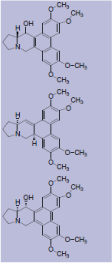 |
Small panel of human cancer cells | Cytotoxic | [35] | |
| 14 | (-)-10 beta-Antofine N-oxide |  |
Drug-sensitive KB-3-1; Multi-drug-resistant KB-V1 cancer cell line | Cytotoxic | [38] | |
| 15 | (-)-10beta,13alpha,14beta-Hydroxyantofine N-oxide |  |
Drug-sensitive KB-3-1; Multi-drug-resistant KB-V1 cancer cell line | Anti-tumor | [2,38] | |
| 16 | Pergularinine |  |
DHFR, (5,6,7,8-THF: NADP+ oxidoreductase, EC 1.5.1.3) enzyme probe | DHFR inhibiting activity | Anti-cancer; Anti-microbial | [39] |
| 17 | Tylophorinidine |  |
DHFR, (5,6,7,8-THF: NADP+ oxidoreductase, EC 1.5.1.3) enzyme probe | DHFR inhibiting activity | Anti-cancer; Anti-microbial | [39] |
| 18 | Hypoestestatin 1 |  |
Ehrlich ascites tumor cells | Inhibits the incorporation of leucine into protein and thus inhibits the tumor cell growth | Anti-tumor | [47] |
| 19 | Hypoestestatin 2 |  |
Ehrlich ascites tumor cells | Inhibits the incorporation of leucine into protein and thus inhibits the tumor cell growth | Anti-tumor | [47] |
| 20 | 3,14-dihydroxy-6,7-dimethoxyphenanthroindolizidine |  |
A549, DLD-1 and K562 tumor cells | Anti-cancer | [48] | |
| 21 | Phenanthro[2,ÃÆâÃâââ¬Ãâââ¬Â¹3-ÃÆâÃâââ¬Ãâââ¬Â¹d]ÃÆâÃâââ¬Ãâââ¬Â¹[1,ÃÆâÃâââ¬Ãâââ¬Â¹3]ÃÆâÃâââ¬Ãâââ¬Â¹dioxole-ÃÆâÃâââ¬Ãâââ¬Â¹5-ÃÆâÃâââ¬Ãâââ¬Â¹carboxylic acid, 2-ÃÆâÃâââ¬Ãâââ¬Â¹(phenylmethoxy)ÃÆâÃâââ¬Ãâââ¬Â¹- |  |
A549 lung cancer cells | Anti-tumor activity | [49] | |
| 22 | 6-O-Demethylantofine | 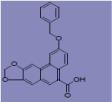 |
Human A-ÃÆâÃâââ¬Ãâââ¬Â¹549 cell and HL-ÃÆâÃâââ¬Ãâââ¬Â¹60 cancer cell lines. | Causes >80% tumor cell inhibition | Anti-cancer | [50] |
| 23 | Phenanthroindolizidine derivative |  |
Anti-TMV, Anti-HIV activity and Anti-cancer | [51] | ||
| 24 | Dimethoxy-9,11,12,13,13a,14-hexahydrodibenzo[f,h]pyrrolo[1,2-b]isoquinoline-14-ol |  |
Human colon cancer cells (SW480) | Inhibits the production of NF-KB | Anti-cancer | [53] |
| 25 | Acetic acid (S)-6,7-dimethoxy-9,10,11,12,12a,13-hexahydro-9a-azacyclopenta[b]triphenylen-3-yl ester hydrochloride |  |
Human colon cancer cells (SW480) | Inhibits the production of NF-KB | Anti-cancer | [53] |
| 26 | Hydroxylatedseco-analogs I |  |
A549 and HL60 tumor cell lines. | Causes >80% tumor cell death | Anti-tumor | [54] |
| 27 | Hydroxylatedseco-analogs II |  |
A549 and HL60 tumor cell lines. | Causes >80% tumor cell death | Anti-tumor | [54] |
Table 1: Phenanthroindolizidine alkaloids and their mode of actions.
Docking
Most of the reported literature and patent documents have disclosed the anti-tumor activities of the Phenanthroindolizidine alkaloids against specific tumor cell lines while very few studies were evaluated on in-vivo models. Further with respect to the mechanism of action, the alkaloids and their derivatives have been found to effectively inhibit the overexpression of the proteins such as Tumor necrosis factor-1(TNF-1), COX-2 and NO production. To understand the details of the binding interaction of the alkaloids as well as its derivatives, an In-Silico docking study was carried out against COX-2 enzyme, as research studies show that its regulation is not only important in treating inflammatory disorders but also a useful target to treat cancer
Ligand and protein preparation
Celecoxib (SC-558) is a well known non-steroidal antiinflammatory drug and acts as a selective COX-II enzyme. The ligand structure of Celecoxib (SC-558) as retrieved from the cocrystallized protein structure and the alkaloid derivatives was prepared using the LigPrep module Ver 3.3 to generate structurally correct 3-D molecules. Celecoxib (SC-558) was subjected to Optimized Potential for Liquid Simulations (OPLS)-2005 force field to generate single low energy 3-D structures. Similarly the PA alkaloids and its derivatives reported for their anti-cancer activity in the scientific literature and patent documents were also prepared using the LigPrep module to generate structurally correct 3-D molecules. Co-crystallized structure of COX-2 enzyme bound with Celecoxib (PDB NO: 3LN1) was retrieved from the Protein Data Bank. The co-crystallized structures were imported into the protein preparation wizard of Schrodinger Software (MasteroVer 10). The enzyme exists in the tetrameric form in the crystal. The monomeric chain with celecoxib (SC-558) was retained and others were deleted. Wizard was used to optimize and minimize the protein structure which involves removing undesirable water molecules and cofactors, optimization with OPLS_2005 force filed using standard parameters and other defects in the target protein. Finally, a low energy and structural correct target protein was achieved. This minimized protein was used for further docking analysis.
Grid generation and docking
As the energy minimized protein structure already had the active site for SC-558, the grid was generated by selecting SC-558 ligand as the reference ligand. Active site consisted of Histidine (His) 90, Arginine (Arg) 120, Tyrosine (Tyr) 355, Tyr 385, Arg 513, Valine (Val) 523 and Serine (Ser) 530 residues. Amino acids within 6.5 A of the inhibitor SC-558 were included in grid generation. The generated grid was further used for docking studies. The docking protocol was revalidated by docking the reference ligand Celecoxib into the generated grid. The docked Celecoxib showed similar molecular interaction to the Celecoxib moiety in the crystallographic structure i.e., hydrogen bond formation with Leucine (LEU)-338 and Phenylalanine (PHE)-504 residues as shown in the Figure 7. Similarly the phenanthroindolizidine alkaloids were docked into the binding pocket of COX-2 protein using Glide Module (Ver 6.6) with Extra Precision (XP) mode. The docked molecules were ranked with respect to Glide score
All the molecules docked into the binding pocket of COX-2 protein structure showed a Glide score comparable to that of the reference ligand namely Celecoxib. Celecoxib is reported to show hydrogen bond formation with LEU-338, ARG-499 and PHE-504 residues. It also shows hydrophobic interactions which largely contributes to its enhanced efficacy. The docking scores of the highly scored alkaloids with respect to Celecoxib molecule are reported in the Table 2. These alkaloids included 6-Demethyltylocebrine Ficuseptine; [2,3-d][1,3]dioxole-5- carboxylic acid-2-(phenylmethoxy)-Phenanthroindolizidine and Ficuseptine B which showed the highest Glide score of -11.39, -11.37, and 11.12 respectively. The glide score for these alkaloids was largely contributed by the hydrophobic interaction with the residue in the binding pocket. The binding mode and poses for the highly ranked alkaloids is depicted in Figures 8a-8c. The alkaloid 6-Demethyltylocebrine Ficuseptine is deeply buried into the hydrophobic pocket of COX-2 target protein and showed hydrophobic interaction with the residues in the hydrophobic pocket. The alkaloid[2,3-d][1,3]dioxole-5-carboxylic acid-2- (phenylmethoxy)- Phenanthroindolizidine formed H-bond with ARG 106 and stacking with PHE-504, TYR-371, Tryptophan (TRP)- 373 and TYR-341 residues in the hydrophobic pocket of COX-2 protein. On the other hand Ficuseptine B showed hydrophobic interactions which largely contributed to its high glide score. The docking pose and interactions of the highly ranked molecules is as shown in Figures 8a-8c.
| Ligands | GScore | Glide Energy |
MolWt | LogP o/w | Log S |
|---|---|---|---|---|---|
| 6-Demethyltylocebrine Ficuseptine | -11.39 | -32.71 | 379.455 | 3.77 | -4.027 |
| [2,3-d][1,3]dioxole-5-carboxylic acid-2-(phenylmethoxy)- Phen anthroindolizidine | -11.37 | -38.49 | 372.376 | 4.282 | -4.356 |
| Ficuseptine B | -11.12 | -37.91 | 377.439 | 3.635 | -3.2 |
| Ficuseptine C | -10.98 | -43.81 | 347.413 | 3.588 | -3.186 |
| Ficuseptine M | -10.96 | -38.7 | 409.438 | 3.057 | -2.169 |
| 6-O-Demethylantofine | -10.81 | -17.43 | 349.429 | 3.62 | -4.213 |
| (-)-Antofine | -10.75 | -40.5 | 363.455 | 4.324 | -4.307 |
| Celecoxib | -11.19 | -58.44 | 381.372 | 3.361 | -5.877 |
Table 2: Comparison between the docking Score and other physico-chemical parameters for Celecoxib and the phenanthroindolizidine alkaloids.
The molecules also showed comparable binding Glide Energy with respect to celecoxib. Properties like partition coefficient (log P o/w) and aqueous solubility (log S) properties were also within acceptable ranges as shown below in Table 2.
LigPlot analysis
Analysis was also carried out to get an overview on the hydrogen bond and hydrophobic interactions between the PA alkaloids and the residues of COX-II protein. LIGPLOT software (Ver 1.4) was used to carry out this analysis for the reference ligand Celecoxib and the top three PA alkaloids which had a glide docking score comparable to that of Celecoxib. The interactions for the reference ligand and PA alkaloids are depicted in Figure 9. The software generated the 2D diagrams representing hydrogen and hydrophobic interactions of the ligands with the important target residues. This helped in identifying the key residues contributing to the overall activity. The LigPlot analysis of the reference ligand Celecoxib (9a) and the top three PA alkaloids with high glide docking score; namely 6-Demethyltylocebrine Ficuseptine (9b), Alkaloid [2,3-d][1,3]dioxole-5-carboxylic acid-2- (phenylmethoxy) - Phenanthroindolizidine (9c) and Ficuseptine B (9d) is depicted in Figure 9. The reference ligand Celecoxib showed hydrogen bond formation with specific residues LEU-338 and PHE-504, while the PA alkaloid 6-Demethyltylocebrine Ficuseptine and Ficuseptine B showed hydrophobic interactions and [2,3-d][1,3]dioxole- 5-carboxylic acid-2-(phenylmethoxy)- Phenanthroindolizidine showed hydrogen bonding a well as hydrophobic interactions.
Conclusions
Traditional herbal medicines belonging to countries such as India, Philippines, Sri Lanka, South China, Malaysia and Australia not only include plants belonging to the genus Tylophora, Vincetoxicum, Pergularia and Cynanchum, but also from Hypoestes spp. (Acanthaceae), Cryptocarya spp.(Lauraceae) and Ficus spp. (Moraceae) which mainly contain phenanthroindolizidine alkaloids.
Phytochemically plants belonging to the Asclepiadaceae family mainly include phenanthroindolizidines and phenanthroquinolizidines together with their seco-derivatives and N-oxides. The phenanthroindolizidine alkaloids mainly include (−)-antofine, (−)-(10S,13aR)-antofine, N-oxide and (−)-14b-hydroxyantofine N-oxide, Tylophovatine, Tylophorinidine etc. Recently these phenanthroindolizidine alkaloids and their derivatives have been evaluated for their anti-tumor, antiinflammatory and anti-diabetic properties. The anti-cancer potential of the alkaloids and the derivatives were mainly evaluated in the tumor cell lines. For example (-)-antofine was effective against human lung adenocarcinoma epithelial cell line (A549) and human colon carcinoma cell lines (HCT-8) while Ficuseptines B, C and M were effective against nasopharyngeal carcinoma cell line (HONE-1) and gastric cancer cell line (NUGC- 3). On the other hand the Tylophorine ring-opened analogs showed activity against human lung adenocarcinoma epithelial cells (A549).
The phenanthroindolizidine alkaloids such as tylocrebrine and extracts or leaf powders containing these alkaloids were subjected to Phase-I clinical trials against cancer [55]. However the clinical trials failed due to the toxic effects on the central nervous system. Later on the research was oriented towards the development of derivatives of phenanthroindolizidine alkaloids specifically Tylophorine derivatives and analogues which were found to reduce the CNS related toxicity. Such derivatives which have been proven to reduce the CNS related toxicities mainly comprised of heteroatoms or polar substituents such as hydroxy, amino and other hydrophilic functionalities on the phenanthrene ring as well on the saturated indolizine ring [38]. Hence further studies related to the development of phenanthroindolizidine alkaloids derivatives with reduced CNS toxicities can enhance the development of the alkaloid as an anti-cancer candidate.
Studies related to the mode of actions associated with the phenanthroindolizidine derivatives reveal that the derivatives potentially down-regulate the over expression of the enzymes such as TNF-1, COX-2 and NF-KB in human cancer cells by inactivating Protein kinase B (PKB) also known as Akt which plays an important role in the cellular processes. Studies also revealed that the inactivation of this Protein kinase B (PKB) on treatment with phenanthroindolizidine alkaloidss correlated with the down-regulation of COX-2. However, the inactivation of this Protein kinase B (PKB) on treatment with phenanthroindolizidine alkaloids is also responsible for the down-regulation of NF-KB is still unclear and hence requires further investigations with regards to the molecular mechanisms. Hence the In-Silico study was carried out in order to understand the binding interactions of the phenanthroindolizidine alkaloids only with COX-2 receptor. The In-Silico study reveals that the alkaloids as well as the derivatives possess a greater binding affinity towards the COX-2 enzyme and thus inhibits it’s over expression. Binding affinity towards COX- 2 enzyme supports the anti-inflammatory as well as the anticancer activity of the phenanthroindolizidine alkaloids and its derivatives as reviewed from the patent as well as the scientific literature. All the molecules docked into the binding pocket of COX-2 protein structure with comparable good Glide score with respect to Celecoxib drug. Celecoxib is reported to show hydrogen bond formation with LEU-338, ARG-499 and PHE-504 residues. Amongst the phenanthroindolizidine alkaloids and its derivatives, three of the alkaloids, namely 6-Demethyltylocebrine Ficuseptine, Ficuseptine B and Phenanthro[2,3-d][1,3]dioxole- 5- carboxylic acid-2-(phenylmethoxy) showed hydrophobic and hydrogen bonding interaction respectively with the COX- 2 protein. The In-Silico study also revealed that the alkaloid 6-Demethyltylocebrine Ficuseptine gets deeply buried into the hydrophobic pocket of COX-2 target protein while the second alkaloid [2,3-d][1,3] dioxole-5-carboxylic acid – 2 - (phenylmethoxy) - Phenanthroindolizidine forms H-bond with ARG 106 and - stacking with PHE-504, TYR-371, TRP-373 and TYR-341 residues in the hydrophobic pocket of COX-2 protein.
Recent studies have also shown the development of specific tumors due to the onset or presence of autoimmune and inflammatory disorders. Autoimmune diseases usually arise from an abnormal immune response of the body against substances and tissues normally present in the body. On the other hand, inflammatory disorders are due to the disturbances in the functioning of some of the factors such as Interleukins, Cytokines, TNF alpha or inflammatory enzymes namely Lipoxygenases such as COX-2. Amongst these factors, research studies have reported that overexpression of COX-2 is also responsible for causing various human tumors. Since the natural as well as the synthetically derived phenanthroindolizidine derivatives such as 6-Demethyltylocebrine Ficuseptine, Ficuseptine B and [2,3-d][1,3]dioxole-5-carboxylic acid, 2-(phenylmethoxy) - Phenanthroindolizidine are reported for their anti-tumor activity, the findings from the docking study reveal that these ligands may possess anti-tumor activity by inhibiting the overexpression of COX-2. Most of the molecules which docked well with the COX-2 protein were ficuseptine alkaloids isolated from the roots of Ficus septica. The enantioselectivity of the phenanthroindolizidine alkaloids towards COX-2, NF-KB, TNF-1 or VEGFR2 which are promising targets for treating cancer can also be explored. Tylocrebrine or Tylophorine based analogues with reduced CNS toxicity can be considered for further evaluation in clinical trials. Therefore, research focused on the development of phenanthroindolizidine alkaloids which can act as anti-inflammation based anticancer agents will have important clinical significance and market value. Further identification of the biomolecular targets of these alkaloids, other than TNF- 1, NF-KB and COX-2 can assist in developing more potent antiinflammatory based anti-cancer therapeutics.
Acknowledgements
I wish to take this opportunity to express my deep gratitude to Dr. R. R. Hirwani, Head, CSIR – Unit for Research and Development of Information Products (URDIP), Pune for giving me an opportunity to work on this project and providing necessary facilities in the research unit. I would also like to thank my colleagues Ms. R. Jansi and Ms. Jyoti Phatak for providing the necessary technical support to write the review article
Funding
There was no funding for preparing this manuscript.
Competing and Conflicting Interests
The authors declare no competing financial interest
References
- G W Pharma Limited (2011)Otsuka Pharmaceutical Co. Ltd. Phytocannabinoids in the treatment of cancer.
- Gellert E (1982)TheIndolizidine Alkaloids. J Nat Prod 45: 50-73.
- Ratnagiriswaran AN, Venkatachalam K (1935) The Chemical Examination of Tylophoraasthmatica and the Isolation of the Alkaloids Tylophorine and Tylophorinine. Indian J Med Res 22: 433-442.
- Capo M,Saa JM (1989) (--)-Antofine: a Phenanthroindolizidine from Vincetaxicumnigrum. J Nat Prod 52: 389-390.
- You X, Pan M, Gao W, Shiah HS, Tao J, et al. (2006) Effects of a Novel Tylophorine Analog on Collagen-Induced Arthritis Through Inhibition of the Innate Immune Response. Arthritis Rheum 54: 877-886.
- Choi JY, Gao W, Odegard J,Shiah HS, Kashgarian M (2006)Abrogation of Skin Disease in LUPUS-Prone MRL/FASlpr Mice by Means of A Novel Tylophorine Analog.Arthritis Rheum54: 3277-3283.
- Yang CW, Chen WL, Wu PL, Tseng HY, Lee SJ(2006)Anti-Inflammatory Mechanisms of Phenanthroindolizidine Alkaloids. MolPharmacol 69: 749-758.
- Baumgartner B, Erdelmeier CAJ, Wright AD, TopulRali, Otto Stichera, etal. (1990)An antimicrobial alkaloid from Ficusseptica.Phytochemistry 29: 3327-3330.
- Chuang T, Lee S, YangC, Wu PL (2006)Expedient synthesis and structure-activity relationships of phenanthroindolizidine and phenanthroquinolizidine alkaloids. Org BiomolChem4: 860-867.
- Damu AG, Kuo PC, Shi LS, Li CY, Kuoh CS, et al. (2005) Phenanthroindolizidine Alkaloids from the Stems of Ficus septic.J Nat Prod 68: 1071-1075.
- Guifang H, Yuxiu L, Qingmin W (2013) Total Synthesis of Phenanthroindolizidine Alkaloids through an Amidyl Radical Cascade/Rearrangement Reaction. Org Lett15: 5334-5337.
- Staerk D, Christensen J, Lemmich E,Duus JO, Olsen CE, et al. (2000) Cytotoxic activity of some phenanthroindolizidine N-oxide alkaloids from Cynanchumvincetoxicum. J Nat Prod 63: 1584-1586.
- Staerk D, Lykkeberg A, Christensen J, Budnik BA, Abe F, et al. (2002) In vitro Cytotoxic activity of phenanthroindolizidine alkaloids from Cynanchumvincetoxicum and Tylophoratanakaeagainst drug-sensitive and multidrug-resistant cancer cells. J Nat Prod 65: 1299-1302.
- Amrita A,Subramaninam B, Rajasekaran C, Seenivasan, Ramamoorthy, et al. (2014) Colorants and cancer: A review. Industrial Crops and Products 53: 167-186.
- Gellert E, Pelletier SW (1987)Alkaloids, chemical and biological perspectives, Academic Press, New York, 55-132.
- Li Z, Jin Z, Huang R (2001) Isolation, Total Synthesis and Biological Activity of Phenanthroindolizidine and Phenanthroquinolizidine Alkaloids. Synthesis16: 2365-2378.
- NayakG, Sing V, Singh K,Chakraborthy PS, Kaushik S, et al (2010)Tylophoraindica - A multicentric clinical verification study. IndJ Res Homoeopathy 4: 12-18.
- Sabitha Rani, Patnaik S, Sulakshanaand G, et al. (2012) Review of Tylophoraindica- an Antiasthmatic Plant. FS J Res Basic & App Sci1: 20-21.
- Kaur H, Anand M, Goyal D (2011) Extraction of Tylophorine from in vitro raised plants of Tylophoraindica. Journal of Medicinal Plants Research 5: 729-734.
- Yap VA, Loong BJ, Ting KNLoh SH, Yong KT, et al (2015)Hispidacine, an unusual 8,4’-oxyneolignan-alkaloid with vasorelaxant activity, and hispiloscine, an antiproliferativephenanthroindolizidine alkaloid, from Ficushispida Linn. Phytochemistry, 109: 96-102.
- Lansky EP, Paavilainen HM, Pawlus AD, Newman RA (2008)Ficus spp. (fig): ethnobotany and potential as anticancer and anti-inflammatory agents. J of Ethnopharmacol119:195-213.
- Ali M, Chaudhary N (2011)FicushispidaLinn.:A review of its pharmacognostic and ethnomedicinal properties. Pharmacogn Rev 5: 96-102.
- Wu TS, Su CR, Lee KH (2012) Cytotoxic and Anti-HIV Phenanthroindolizidine Alkaloids from Cryptocaryachinensis, Nat ProdCommun7: 725-727.
- Mangla VK, Bhakuni DS (1980)Synthesis of tylophorine. Tetrahedron36: 2489-2490.
- Mangla VK, Bhakuni DS (1981) Biosynthesis of tylophorine and tylophorinine. Tetrahedron 37: 401-407.
- Herbert RB, Jackson FB (1977)Biosynthesis of phenanthroindolizidine alkaloids from 6,7-diphenylhexahydroindolizines. J Chem SOC, ChemCommun24: 955-956.
- Mulchandani NB, Iyer SS, BadhekaLP (1971)Incorporation of phenylalanine-2-C into tylophorine.Phytochemistry 10: 1047-1050.
- Herbert RB, Jackson FB, Nicolson IT (1984)Biosynthesis of phenanthroindolizidinealkaloids: incorporation of 2-pyrrolidin-2-ylacetophenone and benzoylacetic acid and derivatives.J ChemSoc Perkin Tran 1 825-831.
- Michael JP (2008)Indolizidine and quinolizidine alkaloids.Nat Prod Rep16: 675-696.
- Yong W, Herndon JW (2013) Total synthesis of (+)-antofine and (-)-cryptopleurine. Europea J Org Chem 15.
- Min HY, Chung HJ, Kim EH, Kim S, Park AJ, et al. (2010) Inhibition of cell growth and potentiation of tumor necrosis factor-?alpha (TNF-alpha)? - ?induced apoptosis by a phenanthroindolizidine alkaloid antofine in human colon cancer cells. BiochemPharmacol80: 1356-1364.
- Lee SK, Nam KA, HeoYH (2003) Cytotoxic Activity and G2?/M Cell Cycle Arrest Mediated by Antofine, A Phenanthroindolizidine Alkaloid Isolated from CynanchumPaniculatum. Planta Med 29: 21-25.
- Liu Z,Lv H, Li H, et al (2011) Interaction studies of an anticancer alkaloid, (+)?-?(13aS)?-?deoxytylophorinine, with calf thymus DNA and four repeated double-?helical DNAs. Chemotherapy57: 310-320.
- Rao K, Venkatachalam S (2000) Inhibition of dihydrofolatereductase and cell growth activity by the phenanthroindolizidine alkaloids pergularinine and tylophorinidine. ToxicolIn Vitro 14: 53-59.
- Wu CM, Yang CW, Lee YZ, Chuang TH, Wu PL, et al. (2009)Tylophorine arrests carcinoma cells at G1 phase by down regulating cyclin A2 expression. BiochemBiophys Res Commun 386: 140-145.
- Yang CW, Lee YZ, Hsu HY, Wu CM, Chang HY, et al (2013) c-?Jun-?mediated anticancer mechanisms of tylophorine. Carcinogenesis34: 1304-1314.
- Gao W, Bussom S, Grill SP, Gullen EA, Hu YC, et al. (2007) Structure-?activity studies of phenanthroindolizidine alkaloids as potential antitumor agents. Bioorg Med ChemLett 17: 4338-4342.
- Gao W, Lam W, Zhong S, Kaczmarek C, Baker DC, et al. (2004) Novel mode of action of tylophorine analogs as antitumor compounds. Cancer Res 64: 678-688.
- Peraza-Sánchez SR, Chai HB, ShinYG, Santisuk T, Reutrakul V, et al. (2002) Constituents of the leaves and twigs of Ficushispida. Planta Med 68: 186-188.
- Arya R, Bhutkar S, Dhulap S, Hirwani RR 2015) Patent Analysis as a Tool for Research Planning: Study on Natural Based Therapeutics Against Cancer Stem Cells. Recent Patents on Anti-Cancer Drug Discovery 10:72-86.
- Lin JC, Yang SC, Hong TM, Yu SL, Shi Q, et al. (2009)Phenanthrene-Based Tylophorine-1 (PBT-1) Inhibits Lung Cancer Cell Growth through the Akt and NF-?B Pathways.Journal of Medicinal Chemistry52: 1903-1911.
- Yang CW, Lee YZ, Hsu HY, Wu CM, Chang HY, et al. (2013) c-Jun-mediated anticancer mechanisms of tylophorine. Carcinogenesis34: 304-314.
- Shiah H, Gao W, Baker DC, Cheng YC (2006) Inhibition of cell growth and nuclear factor-kappaB activity in pancreatic cancer cell lines by a tylophorine analogue, DCB-3503. Molecular Cancer Therapeutics 5: 2484-2493.
- Lv H, Ren J, Ma S,Xu S, Qu J et al (2012) Synthesis, biological evaluation and mechanism studies of deoxytylophorinine and its derivatives as potential anticancer agents. PLoS One 7.
- Pettit GR, Goswami A, Cragg GM, Schmidt JM, Zou JC (1984) Antineoplastic agents.103.The isolation and structure of hypoestestatins 1 and 2 from the East African Hypoestesverticillaris. J Nat Prod 47: 913-919.
- Miguelez J, Boto A, Marin R, Diaz M (2013) Simplification of antitumoralphenanthroindolizidine alkaloids: Short synthesis of cytotoxic indolizidinone and pyrrolidine analogs. Eur J Med Che 66: 540-554.
- Otsuka Pharm Co Ltd (1983) Novel Aristolochine derivatives.
- JP Agency of Nat Cancer CT (2001) Organization for Pharmaceutical, Wakabayashi K, et.al. Antitumor Agents.
- Lee KH, Wei L(2007)Tylophorine analogs as antitumor agents. University of North Carolina, USA.
- Nankai U,Medica SIM (2011)Phenanthroindolizidine alkaloid derivates and salt thereof as well as application of anti-cancer activity of phenanthroindolizidine alkaloid derivates and salt thereof.
- UnivNankai (2013)Phenanthroindo(quio)lizidine alkaloid derivative, and preparation, anti-TMV activity, anti-HIV activity and anti-tumor activity thereof.
- National Health Research Institutes (2005) Phenanthroindolizidine alkaloids.
- Takashi I, Seigo S, Takashi Y, Takeshi M, Shusuke H (2010) Phenanthroindolizidine derivative and NF-KB inhibitor containing same as active ingredient.
- Gopalakrishnan, C, Shankaranarayan D, Kameswaran, L., NatarajanS (1979) Pharmacological investigations of tylophorine, the major alkaloid of Tylophoraindica. Indian J Med Res 69: 513-520.
- ChemlerSR (2009)Phenanthroindolizidines and Phenanthroquinolizidines: Promising Alkaloids for Anti-Cancer Therapy. CurrBioactCompd5: 2-19.
Open Access Journals
- Aquaculture & Veterinary Science
- Chemistry & Chemical Sciences
- Clinical Sciences
- Engineering
- General Science
- Genetics & Molecular Biology
- Health Care & Nursing
- Immunology & Microbiology
- Materials Science
- Mathematics & Physics
- Medical Sciences
- Neurology & Psychiatry
- Oncology & Cancer Science
- Pharmaceutical Sciences
